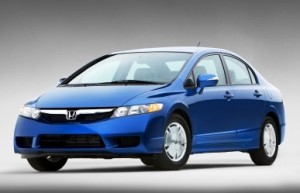
A new study finds that occupants of gas-electric vehicles, like this 2010 Honda Civic Hybrid, are less likely to suffer injuries in collisions.
Mass may be the enemy when it comes to fuel economy but it offers a distinctive advantage when it comes to a crash – which may be a main reason why a new study shows that occupants are likely to come out better in a collision involving a hybrid vehicle than if they were riding in the same model using a conventional powertrain.
A study of 25 vehicles produced between 2003 and 2011 which offered both hybrid and conventional powertrains found that there was a 27% lower injury rate in the gas-electric models, according to the Highway Loss Data Institute.
There’s a downside to the study, however, HLDI finding that in pedestrian accidents involving hybrids, there was a 20% higher injury rate.
“Weight is a big factor,” says Matt Moore, an author of the report and an HLDI vice president. “Hybrids on average are 10 percent heavier than their standard counterparts. This extra mass gives them an advantage in crashes that their conventional twins don’t have.”
The 25 models included in the study were offered with both conventional gasoline as well as hybrid powertrains – which excluded such hybrid-only products as the Toyota Prius. The difference in mass between the two versions varied by model, but at 3,600 pounds, a hybrid version of the Honda Accord was 480 pounds – or 15% — heavier than the gas model. A hybrid Toyota Highlander weighed in at 4,500, or 8% heavier than the gas-powered SUV.
There may be other factors at play, however. Hybrids tend to be driven by less aggressive drivers than those behind the wheel of conventional vehicles, HLDI officials note.
Though there have been some concerns about the added costs for repairing more complex hybrids, the new study also noted that insurance claims for gas-electric models averaged about 25% less than for gas-only versions – largely due to lower injury claims.
The increase in pedestrian accidents somewhat offsets the benefits in the new HLDI study, with data showing a 20% increase in pedestrian injuries. But why is a matter of speculation.
“When hybrids operate in electric-only mode pedestrians can’t hear them approaching,” says Moore, “so they might step out into the roadway without checking first to see what’s coming.”
That’s a major reason why federal regulators have begun the process of setting down new regulations which would require vehicles operating in battery mode to provide some sort of warning noise when they are driving in an urban environment. The new rules should be in place by mid-decade.
